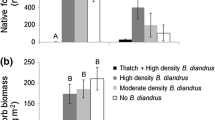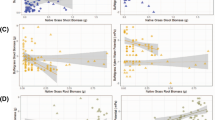Abstract
Dryland native plant communities are threatened by increasing aridity and the progressive expansion of invasive plant species regionally. Red brome (Bromus madritensis ssp. rubens; “B. rubens” hereafter) is one of the most rapidly spreading invasive plants in California. Here, we experimentally tested the independent and joint effects of B. rubens competition and water availability on the establishment, survival, and per capita biomass of three native forb species common to California drylands. In a controlled greenhouse setting, five watering regimes ranging from extreme dry to extreme wet were introduced through controlled watering every 10 days, and B. rubens competition was introduced by growing native plants either in the presence or absence of B. rubens. Bromus rubens did not impact the establishment or survival of any of the three native forbs but did negatively influence the per capita biomass of two of the three native species. Competitive effects did not vary with water availability, suggesting that the negative effects of B. rubens on native competitors may depend more upon species identity than soil moisture conditions in California drylands. We suggest that the native forb Phacelia tancetifolia may be useful in restoration plantings [in areas affected by B. rubens] because this native species maintained consistent biomass across the range of watering levels tested and regardless of B. rubens presence.

Similar content being viewed by others
Data availability
All data is publicly available and the statistical analyses are available within reproducible documents (https://doi.org/10.5281/zenodo.7044863).
References
Alpert P, Bone E, Holzapfel C (2000) Invasiveness, invasibility and the role of environmental stress in the spread of non-native plants. Perspect Plant Ecol Evol Syst 3:52–66
Byun C, de Blois S, Brisson J (2018) Management of invasive plants through ecological resistance. Biol Invasions 20:13–27
Côté IM, Darling ES, Brown CJ (2016) Interactions among ecosystem stressors and their importance in conservation. Proc R Soc B Biol Sci 283:20152592
Davis MA, Grime JP, Thompson K (2000) Fluctuating resources in plant communities: a general theory of invasibility. J Ecol 88:528–534
DeFalco LA, Bryla DR, Smith-Longozo V, Nowak RS (2003) Are Mojave Desert annual species equal? Resource acquisition and allocation for the invasive grass Bromus madritensis subsp. rubens (Poaceae) and two native species. Am J Bot 90:1045–1053
Diffenbaugh NS, Swain DL, Touma D (2015) Anthropogenic warming has increased drought risk in California. Proc Natl Acad Sci 112:3931–3936
Farrell HL, Funk J, Law D, Gornish ES (2022) Impacts of drought and native grass competition on buffelgrass (Pennisetum ciliare). Biol Invasions 24:697–708
Filazzola A, Westphal M, Powers M, Liczner AR, Woollett DAS, Johnson B, Lortie CJ (2017) Non-trophic interactions in deserts: facilitation, interference, and an endangered lizard species. Basic Appl Ecol 20:51–61
Fox J, Weisberg S, Adler D, Bates D, Baud-Bovy G, Ellison S, Firth D, Friendly M, Gorjanc G, Graves S (2012) Package ‘car.’ R Foundation for Statistical Computing, Vienna
Germino MJ, Belnap J, Stark JM, Allen EB, Rau BM (2016) Ecosystem impacts of exotic annual invaders in the genus bromus. In: Germino MJ, Chambers JC, Brown CS (eds) Exotic Brome-Grasses in Arid and Semiarid Ecosystems of the Western US. Springer International Publishing, Cham, pp 61–95
Housman DC, Yeager CM, Darby BJ, Sanford RL, Kuske CR, Neher DA, Belnap J (2007) Heterogeneity of soil nutrients and subsurface biota in a dryland ecosystem. Soil Biol Biochem 39:2138–2149
Hutchings M, John E (2004) The effects of environmental heterogeneity on root growth and root/shoot partitioning. Ann Bot 94:1–8
Inouye BD (2001) Response surface experimental designs for investigating interspecific competition. Ecology 82:2696–2706
Jurand BS, Abella SR (2013) Soil seed banks of the exotic annual grass Bromus rubens on a burned desert landscape. Rangel Ecol Manage 66:157–163
Leger EA, Espeland EK (2010) The shifting balance of facilitation and competition affects the outcome of intra- and interspecific interactions over the life history of California grassland annuals. Plant Ecol 208:333–345
Lenth, R., H. Singmann, and J. Love. 2018. Emmeans: Estimated marginal means, aka least-squares means. R package version 1.
Lüdecke, D., D. Makowski, P. Waggoner, and I. Patil. 2020. Performance: Assessment of regression models performance. R package version 0.4.5.
NOAA. 2007. Local climatological data, Stations 123, 210, 211, 212, California. National climatic data center, national oceanic and atmospheric administration, Asheville, N.C.
Pik D, Lucero JE, Lortie CJ, Braun J (2020) Light intensity and seed density differentially affect the establishment, survival, and biomass of an exotic invader and three species of native competitors. Community Ecol 21:259–272
R Core Team. 2022. R: A language and environment for statistical computing. R Foundation for Statistical Computing.
Sala OE (2000) Global biodiversity scenarios for the year 2100 & nbsp. Science 287:1770–1774
Salo LF (2005) Red brome (Bromus rubens subsp. madritensis) in North America: possible modes for early introductions, subsequent spread. Biol Invasions 7:165–180
Seabloom EW, Williams JW, Slayback D, Stoms DM, Viers JH, Dobson AP (2006) Human impacts, plant invasion, and imperiled plant species in California. Ecol Appl 16:1338–1350
Valliere JM, Escobedo EB, Bucciarelli GM, Sharifi MR, Rundel PW (2019) Invasive annuals respond more negatively to drought than native species. New Phytol 223:1647–1656
Warter MM, Singer MB, Cuthbert MO, Roberts D, Caylor KK, Sabathier R, Stella J (2021) Drought onset and propagation into soil moisture and grassland vegetation responses during the 2012–2019 major drought in Southern California. Hydrol Earth Syst Sci 25:3713–3729
Funding
This work was supported by a NSERC Discovery grant to CJL.
Author information
Authors and Affiliations
Contributions
N.F., J.L. and C.J.L. designed the experiment, N.F. collected the data, J.B. analyzed the data and wrote the first draft, and all authors contributed to the final draft.
Corresponding author
Ethics declarations
Competing interests
The authors have no relevant financial or non-financial interests to disclose.
Additional information
Publisher's Note
Springer Nature remains neutral with regard to jurisdictional claims in published maps and institutional affiliations.
Supplementary Information
Below is the link to the electronic supplementary material.
Rights and permissions
Springer Nature or its licensor (e.g. a society or other partner) holds exclusive rights to this article under a publishing agreement with the author(s) or other rightsholder(s); author self-archiving of the accepted manuscript version of this article is solely governed by the terms of such publishing agreement and applicable law.
About this article
Cite this article
Braun, J., Lucero, J.E., Lortie, C.J. et al. Competitive effects of an invasive grass on native annuals are species-specific and independent of water availability. Biol Invasions 25, 3353–3359 (2023). https://doi.org/10.1007/s10530-023-03127-y
Received:
Accepted:
Published:
Issue Date:
DOI: https://doi.org/10.1007/s10530-023-03127-y




